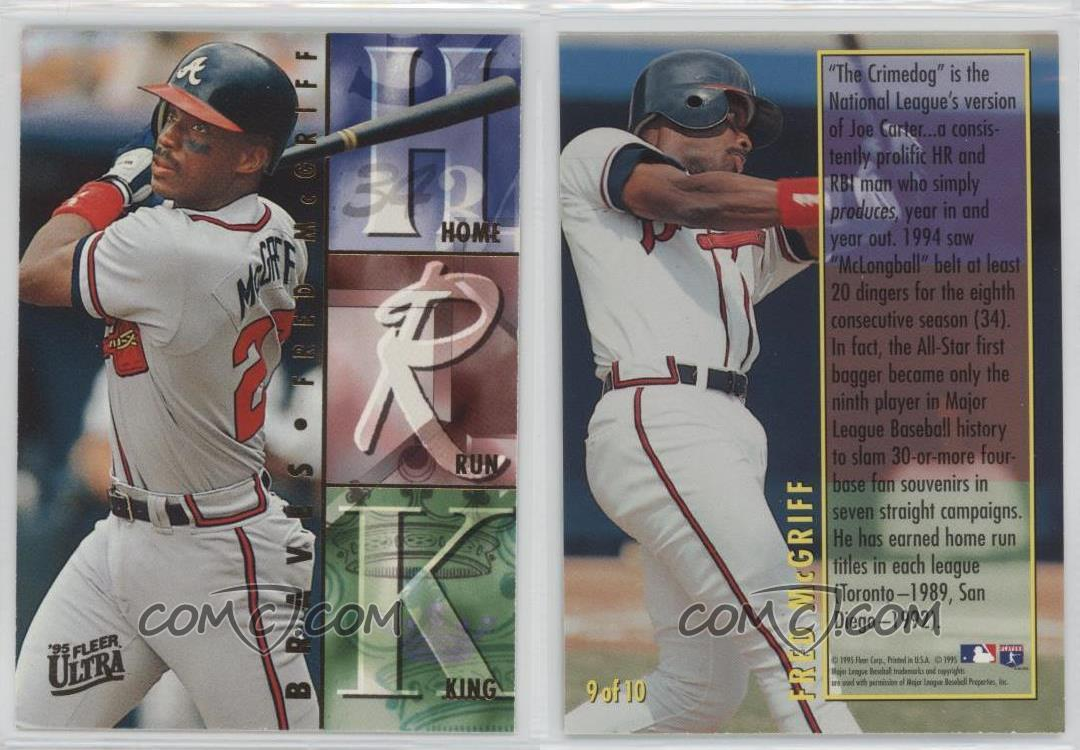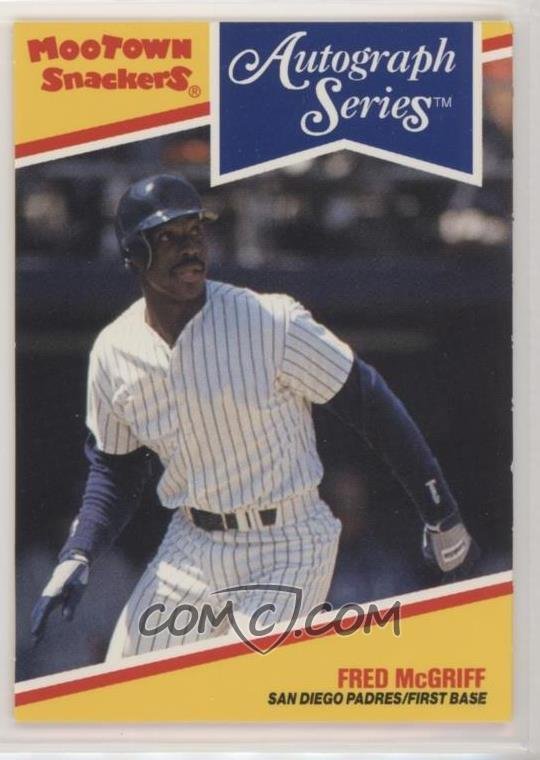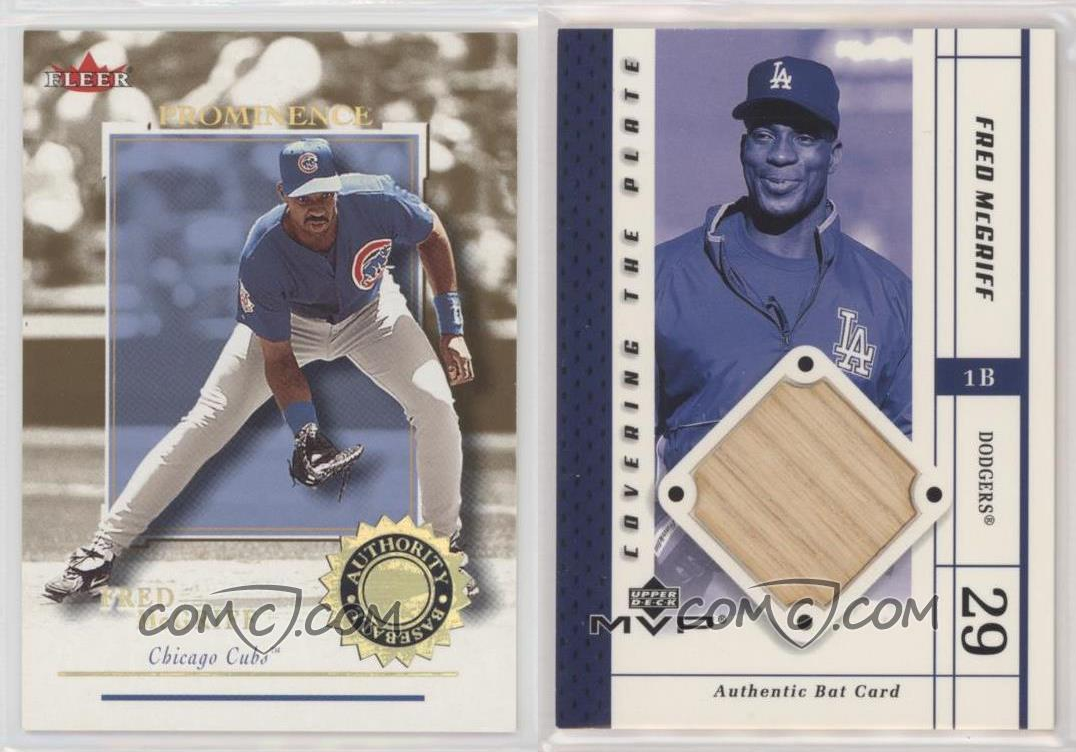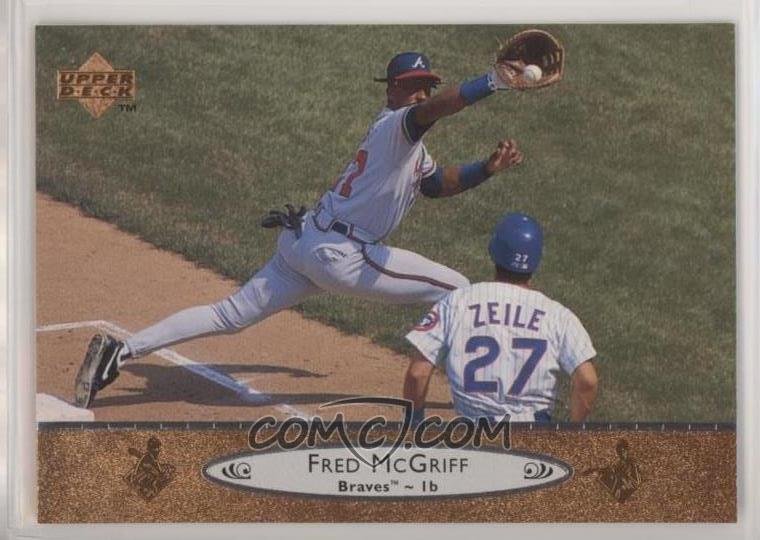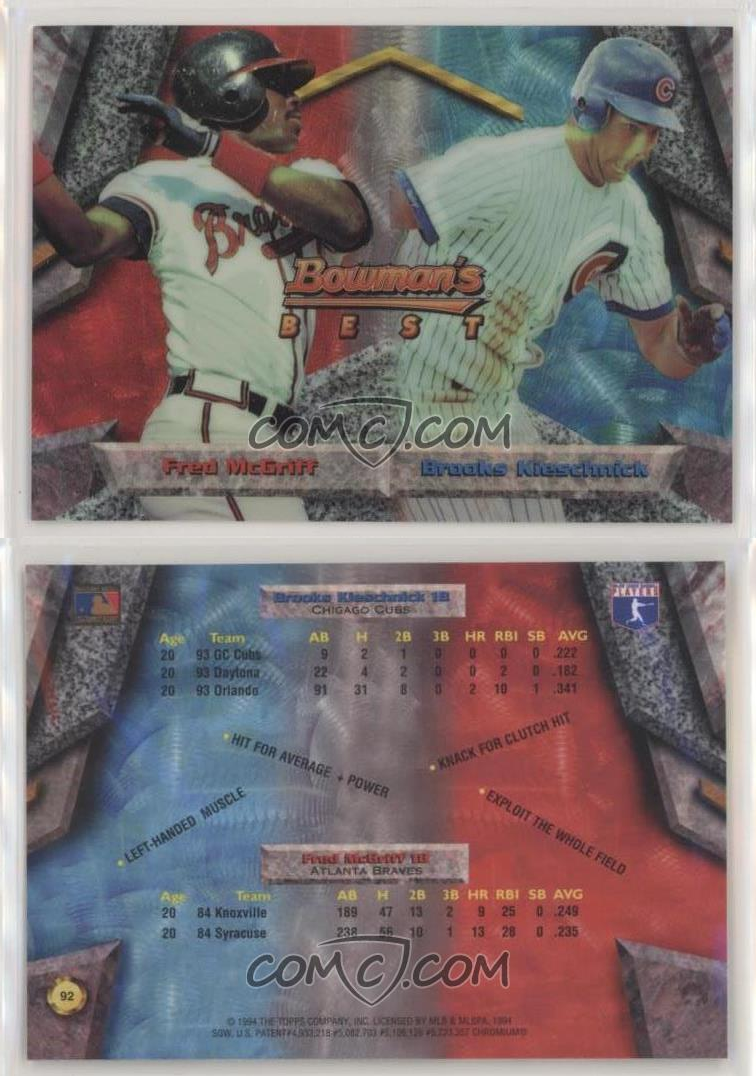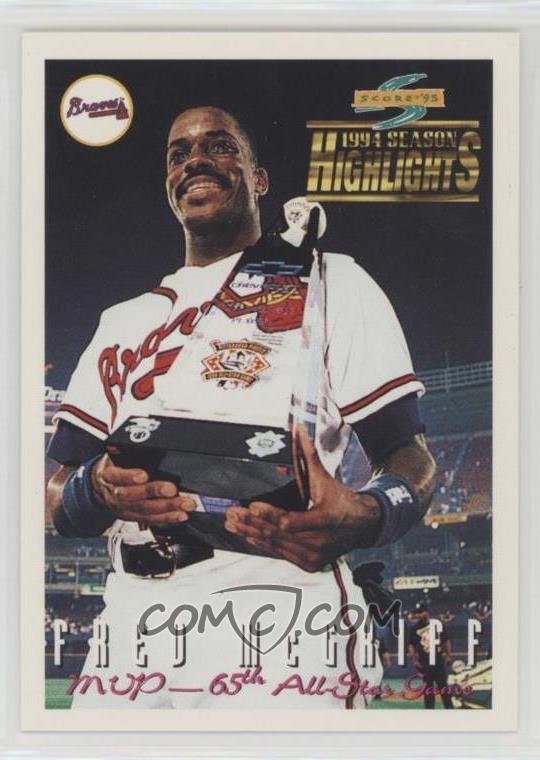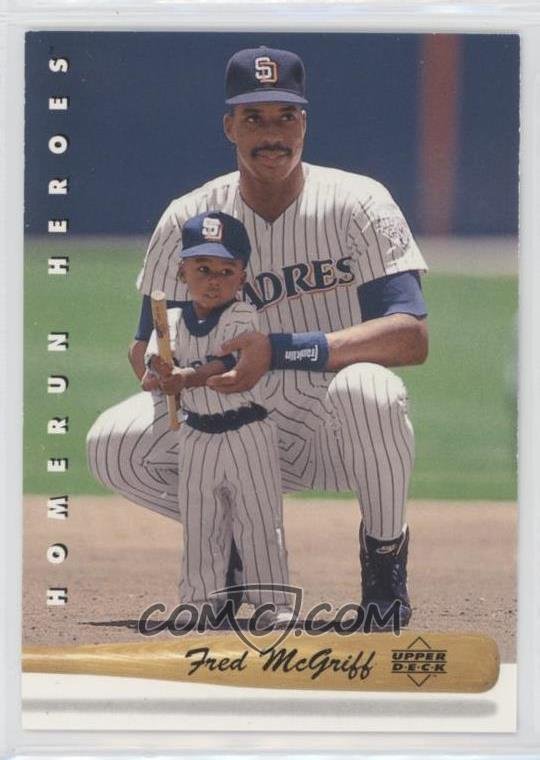Best Cards: Fred McGriff
(This is Best Cards Ever, a never-ending quest to find the single best baseball card of every player.)
A few years ago on Twitter, Jared Diamond asked a question. “Why does Baseball Twitter as an entity seem to overwhelmingly favor a large Hall of Fame?”
I answered this in a tweet as well, but I’ll reiterate here: The answer is because it’s been decided for us. It’s not that we want a large Hall of Fame. It’s that we already have one.
One of the most annoying things in sports (and particularly baseball) discourse, at least to me, is the lionization of past eras. Yeah, Charlie Gehringer was great. So was Jackie Robinson, so was Joe Morgan, so was Craig Biggio, so is Jose Altuve. But there’s a sect of baseball fandom — and that sect includes a lot of the old guard of baseball writers — that insists Gehringer and his peers were the pure form of baseball, distilled to its finest, and that anything that’s come since is in some way less than.
The sabermetric community has made some real inroads into this line of thinking, but it still persists. And if we stuck to a small-Hall line of thinking in the 2010s and 2020s, we’d play into that. “There were 100 Hall of Famers who were active in 1924 but only 30 in 2004 despite double the teams, so baseball must have been so much better then!”
In other words, if we want to debate whether an ideal Hall of Fame — maybe Bill Simmons’ pyramid or whatever — would include Scott Rolen, I’m open to that. It’s a fair debate. But Rabbit Maranville is in, guys. Bill Mazeroski is in. Bruce Sutter and Herb Pennock and Ernie Lombardi are in. The precedent has been set. Rolen is better than those guys, so by the existing Hall of Fame standards already in place, he’s a Hall of Famer. It’s not that we want a large Hall. It’s that that decision wasn’t left up to us.
And all that said … I’m not convinced Fred McGriff should have been a Hall of Famer.
To be clear, McGriff is not the worst Hall of Famer (Harold Baines, maybe?). So maybe I’m arguing against what I said a minute ago. But the induction of McGriff this weekend wasn’t the righting of some egregious historical wrong; it was letting one more Taylor Swift fan cram into standing-room only because “All right, shrug, it’s fine.” Will Clark was better, and he fell off the Hall of Fame ballot in one year. Keith Hernandez was better, and he lasted nine years on the ballot but never topped 10.8%. Todd Helton isn’t in, Don Mattingly isn’t in, Norm Cash isn’t in. Were all of those players better than McGriff? Maybe, maybe not (Clark was). But that’s the tier McGriff is in, not the Jim Thome/Frank Thomas/Hank Greenberg class. It’s no shade. It’s just what it is.
Fred McGriff
Career: 1986-2004 (TOR, SDP, ATL, TB, CHC, LAD)
WAR: 52.6
Hall of Fame: Did … you read the paragraphs just above this?
Fred McGriff was extremely good! I don’t want anything I said above to make it sound like I think he was some ho-hum player who got into the Hall of Fame because of TBS, a Tom Emanski commercial and an absolute absurd Eric Gregg/Liván Hernández called strike. He had five top-10 MVP finishes. He almost had 500 home runs. He was in one of the biggest trades of all time (seriously, a player of McGriff’s level, or Tony Fernández’ level, or Robert Alomar’s level, or Joe Carter’s level being traded by himself would be the headline of the MLB day, and they were all in the same trade).
The main argument for McGriff as a Hall of Famer — and it’s not one I use, but it’s not not a good one — is this: If you ask casual baseball fans to talk about the 1990s in baseball, Fred McGriff wouldn’t be anywhere near the first name they came up with, but he would make it in before the footnotes. He was very good. He was just very good in a time when there were a lot of “very good”-er guys out there.
(As always, thanks to Check Out My Cards for being able to track these down.)
The worst Fred McGriff card
1995 Fleer Ultra – Home Run King #9
Oh lord. We gotta talk:
“HRK” isn’t a thing, Fleer Ultra. I don’t know if you wanted to coin it with this subset, but you really didn’t need to jump straight to the prominent acronym.
That said, that’s a problem with the subset, not the McGriff card itself. But we flip over to the back of the card, and … deep breath:
“Crime Dog” is two words, friends.
“The National League’s version of Joe Carter” is the most “damning with faint praise” phrase of all time. Joe Carter was cool, but, like, no one was excited about that.
“Four-base fan souvenirs.” They were trying so hard on this card. It’s all very, extremely “How do you do, fellow kids?”
But even then, it wouldn’t be his worst card if not for them just straight up giving the dude a new nickname. Like, Crime Dog is an excellent nickname. Or just call him “McGriff,” since that moniker is nowhere else in his blurb. But “McLongball”? That’s not even a good nickname, but also, no one in the history of ever has used it. C’mon guys, try less.
Honorable mention
These aren’t the best of his cards. Sometimes they aren’t even that good. But they need to be mentioned one way or another.
1992 Mootown Snackers Autograph Series – Food Issue #17
It would be really hard to get away with unlicensed cards these days. Not impossible, because Panini insists on continuing to try, but hard. But in the ‘90s, every company with at least three products put out a baseball card as their main enticement, and if you had an airbrush, well, that was way easier than giving MLB some money.
So no shade on the good folks at Mootown Snackers. (And now I’m going to pause and go look up what a “Mootown Snacker” is, but before I do I’m going to guess, and then we’ll see if I’m right … I’m going with string cheese. [Result: cheese dip and crackers. Nuts.]) I don’t know if it was worth it for them to make a set of cards in 1992, but I appreciate that they did, because the me that existed from ages 6 to 11 would have bought any product that had baseball cards. We bought Mootown Snackers. We bought Little Debbies. We bought Milk-Bones. We ate at Denny’s. My card collection was massive and worthless. If they packaged every gram of cocaine with a Will Clark card with the Giants or Rangers logo removed, I’d have died in a gutter before going to my first middle-school dance. Make your cards, y’all. You made some kids real happy.
But you have to be strategic about it. You have to know that a super dark uniform with pinstripes is just going to be a Yankees uniform. Without the interlocking SD, without some light brown on there, there’s not a soul who didn’t look at this card and either think “Who’s that guy who kinda looks like Fred McGriff on the Yankees?” or “Whoa, Fred McGriff’s on the Yankees now?” Doing unlicensed cards was cheaper, I’m sure, but if you’re gonna do that, you have to limit yourselves to pictures when a player looks like he’s playing for the most famous team in American pro sports. Fred McGriff never played for the Yankees. Don’t make it look like he did.
2003 Donruss Classic – Dress Code #DC-53
Because when I’m trying to think about something cool and attractive and catchy to get the young’uns to buy my baseball card, “Dress Code” is what I’m going with.
2001 Fleer Authority – Prominence #15
2003 Upper Deck MVP – Covering the Plate #CP-FM
Y’all, if I really get back into the swing of things in this exercise, I am going to be so good at Immaculate Grid.
1996 Upper Deck #270
I want to create a card collection of “Cards of one guy where another guy is prominently featured.” The collection will hold interest for only me. (And, I guess for this card, Todd Zeile.)
1994 Bowman’s Best – Refractors #92 (Fred McGriff/Brooks Kieschnick)
I think “let’s pair an established veteran with a rookie” is a fun idea … when it makes sense. Which, let’s be honest, it generally doesn’t, and it’s gonna be forced. This one? Very very very very very very (14 more verys) forced. I thought Brooks Kieschnick was fun by the end of his career, the reverse Rick Ankiel (and doing it before Ankiel) by being a joint hitter/pitcher, but he didn’t make his first pitching appearance until 2003. In 1994, he was just a kid coming up. Look at those stats on the back of the card. Look at those sad little bullet points they just threw on the card like they used a Yahtzee shaker. The best commonality they have is “uh, they’re both lefties.” We need the Bart Simpson “At least you tried” meme in the corner of this card.
1995 Pinnacle #276
On my high school newspaper, I convinced our advisor to let me do an activity page. I made a word jumble, I made a crossword puzzle, I got someone with a modicum of artistic ability to draw a cartoon. It wasn’t great, but I was proud of it. But I had this one slot left on the page and couldn’t decide what to put there. I was stuck. I tried enlarging the stuff I had, but it didn’t work. We were up against deadline and I was about to have to scrap my insert page altogether.
Then this kid volunteered that he could fill it. Jacob. “I got you,” he said. I didn’t question it because I didn’t want to lose my crossword, my jumble. I get to see the page on press day (so I super can’t change anything material), and what he’s done is a “Guess the teacher?” game, where he took a picture of a teacher and Photoshopped it with the swirl tool to the point that it was utterly unrecognizable, and then the original picture of the teacher right next to it. Mr. Hill, I believe. It was the most pointless thing in the world — no one could possibly guess the teacher from the edited picture, and the actual picture was right next to it. I appreciated Jacob’s effort, but that ended up being our only activity page that year, and I’m still convinced that is why.
Anyway, I love that baseball cards in the ‘90s could get away with “Here’s a picture of a player, and we’re going to make it fancy by using this rudimentary Photoshop tool in the background for about 1 second. Don’t you love it?”
1998 Leaf Rookies & Stars – True Blue #55
Of the myriad different colors the Rays used, none of them was true blue, sirs.
And now, the top four Fred McGriff cards of all time.
4. 1995 Score #316
Fred McGriff’s most iconic imagery is pointing at the screen in the Tom Emanski videos “that gets results” (that McGriff never actually watched). His second-most iconic imagery is probably getting called looking on that Liván Hernández pitch that was closer to the dugout than to home plate. For a Hall of Fame player, that’s actually a little disappointing. But we should remember McGriff’s 1994 All-Star break. He finished second in the Home Run Derby. He won the All-Star MVP. He ended up being the best offensive player on a Braves team that had the third-best record in baseball (albeit second in their own division) when the strike came down. It wasn’t iconic, but it totally could have been.
Also, imagine how frustrating it had to be for the folks at Score to have to make a “1994 Season Highlights” subset mid-strike when they didn’t know when/if the game would even return. “Last highlights ever” is a depressing idea.
3. 1986 Leaf Canadian #28
“Rated Rookie” should not be the lasting phrase that came out of card collecting in the 1980s and 1990s. It’s super plain and ordinary and banal. But somehow — maybe the double-R graphic, maybe Donruss/Leaf’s stubborn insistence on sticking with it, maybe just fluke — it is. Simple, unexciting, but there it is. This card features him wearing a mesh jersey (batting practice?), with his hand almost certainly all the way down over the knob of the bat. He hadn’t debuted in the big leagues when this card came out, and wouldn’t for a few more months. He had been fine in the minors but nothing that portended the Hall of Famer he would become (.249 average, 84 home runs in 538 games). They thought he’d be fine, but they weren’t planning on a superstar. This was a photographer at the Arizona Fall League seeing a guy walk past as he went to batting practice and saying “Hey, McGruff or whatever, gimme a quick pose,” and McLongball pulling the bat up. I would bet anything McGriff did this photo in about two seconds and forgot about it entirely, and if he had never become anything, it wouldn’t matter now. But as it is, he’s about 22 here, looking like he’d look for the next 20 years (albeit with a thinner mustache), with the iconic “Rated Rookie” branding. It’s just cool.
2. 1994 Upper Deck #225
So I might have been wrong earlier. I didn’t even remember McGriff’s cool end-of-swing pose until I started this exercise, but him wrapping his bat over his head at the end of a big swing ranks somewhere near his most iconic pieces of imagery. It’s undeniably cool, and man did you know when McGriff got one.
(Again with the “Well, we have Photoshop, let’s use it” — I love that the card devotes about 15% of its space to “Same picture, but kinda smooshed.” In the 1990s, they simultaneously had every idea and no idea.)
1. 1993 Upper Deck – Homerun Heroes #HR4
I’ll overlook the “Home Run is two words, guys” of it all, because LOOKIT THE KID HE’S SO CUTE. I don’t know if an card company has ever done a series of “Players with their kids,” but they absolutely should have, it would be the best card set ever.
